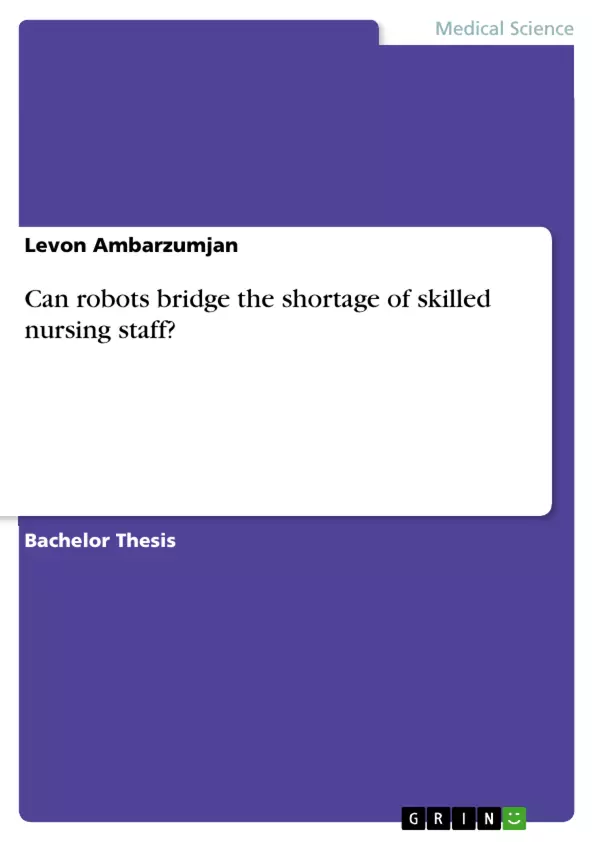The shortage of nursing professionals is regularly discussed by politicians and the public. Due to the growing workload for nurses and poor pay, the nursing profession has lost much of its appeal. At the same time, demographic change is ensuring that the number of people in need of care is steadily increasing. By 2030, Germany is expected to have a shortage of more than 300,000 caregivers.
Previous strategies have not been able to stop the growing shortage of skilled workers. Robotics could offer a new approach to solving the problem. Robotic systems are already being used successfully in industry as well as in the service sector. Could state-of-the-art care robots be integrated into direct human care to address the rising need for care and the growing shortage of skilled workers?
In his work, author Levon Ambarzumjan not only discusses the status quo and the future of the nursing care system in Germany, but also explains coping strategies such as the import of foreign nursing staff or the academization of the nursing profession and developments in nursing robotics. Here, he specifically addresses the advances and difficulties in human-robot interaction, communication and appearance. As a result of his analyses, Ambarzumjan gives a recommendation for a reasonable and realistic use of nursing robots.
Inhaltsverzeichnis (Table of Contents)
- 1 Introduction
- 2 Nursing emergency in Germany
- 2.1 Development and current status
- 3 Causes of the shortage of skilled workers
- 3.1 Demographic change
- 3.2 Shortage of junior staff
- 3.3 Stress factors in the nursing profession
- 4 Previous coping strategies against the shortage of skilled workers in nursing
- 4.1 Import of foreign nurses
- 4.2 Academisation of nursing training
- 5 Opportunities through robotics
- 5.1 Problem statement
- 5.2 Origin and development of robots
- 6 Types of robots
- 6.1 Service robots
- 6.2 Care robots
- 7 Current state of development
- 7.1 Robots as service providers
- 7.2 Human-Robotics Interaction (MRI)
- 7.3 Communication and appearance
- 8 Challenges of nursing robotics
- 8.1 Technical challenges
- 8.2 Organizational challenges
- 8.3 Psychological challenges
- 8.4 Ethical challenges
- 8.5 Economic challenges
Zielsetzung und Themenschwerpunkte (Objectives and Key Themes)
This work examines the growing shortage of skilled workers in the nursing profession in Germany. It analyzes the causes of this shortage, including demographic change, the lack of junior staff, and the stress factors inherent in the nursing profession. The text also investigates previous coping strategies, such as importing foreign nurses and academicizing nursing training. It then explores the potential of robotics as a solution to the nursing shortage, examining the development and capabilities of care robots and their potential integration into direct patient care.
- The nursing emergency in Germany
- Causes of the shortage of skilled workers in nursing
- Previous coping strategies for the nursing shortage
- The potential of nursing robotics
- Challenges of implementing nursing robotics
Zusammenfassung der Kapitel (Chapter Summaries)
The first chapter introduces the issue of the nursing shortage in Germany, highlighting its political and societal significance. Chapter 2 provides a detailed account of the development and current status of the nursing emergency, including historical background, present-day challenges, and projections for the future. Chapter 3 delves into the causes of the nursing shortage, focusing on demographic change, the shortage of junior staff, and the inherent stress factors of the profession.
Chapter 4 analyzes traditional coping strategies, including the import of foreign nurses and the academisation of nursing training. Chapter 5 introduces robotics as a potential solution to the nursing shortage, defining key terms such as service robots and care robots, and exploring the historical development of this technology. Chapter 6 presents the different types of robots, particularly service robots and care robots, and examines the current state of development in nursing robotics.
Chapter 7 explores the challenges of integrating robots into the nursing profession, focusing on technical, organizational, psychological, ethical, and economic considerations.
Schlüsselwörter (Keywords)
The key terms and focus topics of this work include the nursing shortage in Germany, demographic change, stress factors in nursing, coping strategies for the nursing shortage, nursing robotics, service robots, care robots, Human-Robotics Interaction (MRI), and the challenges of implementing nursing robotics.
- Quote paper
- Levon Ambarzumjan (Author), 2019, Can robots bridge the shortage of skilled nursing staff?, Munich, GRIN Verlag, https://www.grin.com/document/1188379



